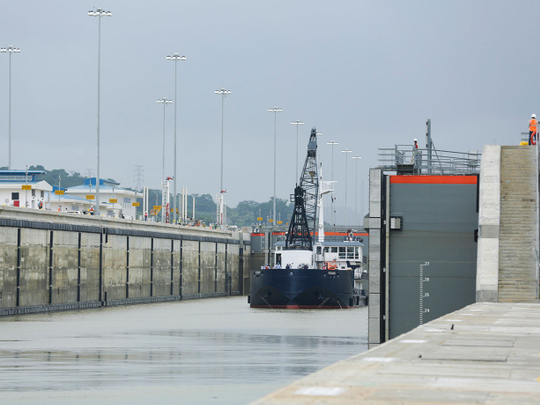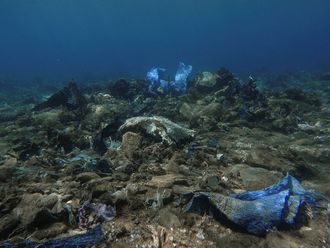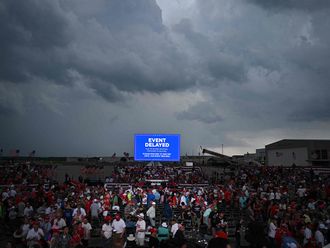
Panama Canal: The colossal freighter, guided by a pair of tug boats that looked like gnats in comparison, eased toward the entrance of the Panama Canal, the passageway traversed more than a million times since its debut more than a century ago.
This time, however, expectation hovered in the steamy air. Hundreds of workers in hard hats and multicoloured safety vests gathered to watch as the MN Baroque glided toward a new set of locks.
“This is a major advance not just for Panama, but for the world,” said Xionara Martinez, 43, a cement worker and mother of two who was among the spectators applauding and taking photos with their cell phones.
Gigantic carriers such as the MN Baroque — more than 50 metres wide and three football fields in length — have never fit through the Model T-era passage, constructed well before the emergence of supersized cargo ships. But that is about to change.
The test of the new locks this month offered a glimpse into the canal’s future, which begins this Sunday with the inauguration of a deeper, wider Panama Canal that can handle twice as much cargo.
The $5.4-billion project, nine years in the making, is aimed at boosting the competitiveness of the 80-kilometre shortcut between the Atlantic and the Pacific and maintaining its ability to generate billions of dollars a year for the central American nation.
“We knew for a long time we had to think about expanding, otherwise we would lose relevancy in the world,” said Ilya R. Espino de Marotta, who oversees the project for the Panama Canal Authority, an autonomous agency of the government of Panama. “We were being maxed out.”
The upgrades have implications far beyond Panama. It could reshape world trade routes, opening new markets for commodities from South America, pushing back against competition from the Suez Canal and shifting how goods enter the United States.
At stake is how imports will reach a vast swath of the American heartland, running from Chicago and south along the Mississippi River, stretching as far west as Dallas. Because bigger ships will now fit through the canal, some analysts predict that more ships will dock on the East and Gulf coasts, diverting business from the nation’s two busiest ports — Los Angeles and Long Beach.
“People have been scratching their heads and sharpening their pencils ever since the Panamanians announced they would construct a new canal,” said Jock O’Connell, an international trade adviser at Beacon Economics, a Los Angeles research firm. “After all this time we still don’t have a definitive sense of what will happen.”
One of the world’s greatest public works projects, the original canal, built by the United States and completed in 1914, was a feat of engineering and perseverance that cost the lives of thousands of workers, many from malaria or yellow fever during an earlier, failed effort by the French.
The overhaul is its own epic story. Workers blasted a new four-mile access channel on the Pacific side and conducted massive dredge operations to expand the existing routes.
The 16 new sluice gates — the doors of the new locks that raise and lower ships in and out of the canal — were made in Italy and arrived stacked on barges that together looked like a postmodern Stonehenge on the sea. The gates, each weighing thousands of tons and soaring more than 100 feet in the air, were then installed into grooves with the help of remote-controlled vehicles resembling giant skateboards.
“Getting the gates fabricated and brought here was an extremely delicate part of the whole process,” said Giuseppe Quarta, the lead engineer with Salini Impregilo, the Italian firm that is part of the consortium that designed and constructed the locks.
The opening follows years of studies, cost overruns and work stoppages. Eight workers died in construction accidents. More than 6,000 birds, reptiles and amphibians were relocated. Blasting unearthed a 16th century Spanish dagger, arrowheads, and fossils of ancient monkeys, horses, camels and a long-extinct creature known as a “bear dog.”
The improvements essentially add a “third lane” to the waterway and are expected to dramatically reduce traffic jams, the long lines of idling ships that appear as dots on the horizon from the skyscrapers of Panama City.
More importantly, the canal can now accept the massive, so-called neo-Panamax ships. In the highly competitive nautical shipping world, bigger has come to mean cheaper, with reduced labour and fuel costs.
The waterway will accept titanic cargo ships, with containers stacked almost 15 stories high, or massive tankers filled with grain, liquefied natural gas or other cargo. The maximum load is nearly three times as big as it used to be.
The change could have a dramatic effect on world shipping — and in particular on how goods arrive in the world’s most prosperous market.
Currently 37per cent of all shipments to the United States arrive at the ports of Los Angeles or Long Beach, primarily from East Asia, across the Pacific. Many of those goods are sent to the vast middle of the country on trains and trucks.
The Southern California ports have seen their market share decline slightly over the last decade as more consumer items from Asia are being sent the other way around the world through the Suez Canal to ports on the East Coast.
The expansion of the Panama Canal offers another way to get massive ships to those ports. That has important implications not only for the Suez Canal but also for the ports of Los Angeles and Long Beach.
To send goods to the Midwest from Asia, it is generally cheaper to use the canal route to the East Coast and the Gulf states, because the cargo travels fewer miles on costly rail and truck routes.
Ports on the East Coast and the Gulf of Mexico — including New York, Miami and Houston — have been frantically gearing up for a bonanza.
They have deepened their harbours, expanded rail lines and installed massive cranes. The Port Authority of New York and New Jersey spent more than $1 billion to raise the level of the Bayonne Bridge to allow the big ships to pass under the roadway.
“It’s not like we didn’t know it was coming,” said Bethann Rooney, assistant director of port commerce for the Port Authority. “We have done our homework.”
That could be bad news for the Southern California ports.
A study last year by the Boston Consulting Group and C.H. Robinson, a logistics and transportation outfit, estimated that the canal expansion could lead to as much as 10per cent of container traffic between East Asia and US ports moving to the East Coast by 2020.
“They are taking jobs away from Southern Californians that today handle that cargo for the rest of the country,” said Paul Bingham, a trade economist with Economic Development Research Group Inc., a consulting firm in Boston. “If you lose that cargo, the income doesn’t go to Californians, it goes to those other ports.”
If port officials in Southern California are worried, they are not letting on.
“I do think there is some small risk, a low single-digit risk, that some volume will divert,” said Jon Slangerup, the chief executive of the port of Long Beach. “We may lose a little bit of business there.”
There are reasons to believe the effects will be limited.
While it may be cheaper to send Asia-made goods to the Midwest through the expanded canal, it is faster to send them through Los Angeles or Long Beach. For time-sensitive products coming from China and elsewhere, a marginal savings in shipping costs may not outweigh the advantage of products reaching the market more expeditiously, experts said.
Experience could also work in favour of the West Coast. The California ports have far more experience than their East Coast counterparts handling behemoth cargo loads.












